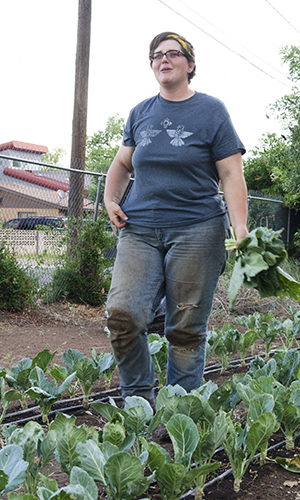
By Casey Holland, Red Tractor Farm
The monsoons finally arrived in August. They were more than a month later than usual, but I am grateful for them all the same. It was apparent that everything growing in our fields was equally grateful for the reprieve from the oppressive summer heat. For the first time in almost two months, the temperature was consistently under 100 degrees for longer than a week. All of our crops were much greener and had a certain vibrancy they lacked back when they were just fighting to stay alive. The outdoor tomatoes finally set fruit and rapidly increased in height. The sweet potatoes grew lush and quintupled in size.
 Unfortunately, the weeds loved the rain, too, and grew at an even faster pace. There were more insects buzzing about, there was an unfamiliar humidity in the air, and the farm had a beautiful tranquility in the early morning before the rest of the city had woken up. Even though a main city road is just a few dozen feet away from our okra patch, standing there made me feel like I was transported back to a time before automobiles. The full bounty of the season had finally arrived.
Unfortunately, the weeds loved the rain, too, and grew at an even faster pace. There were more insects buzzing about, there was an unfamiliar humidity in the air, and the farm had a beautiful tranquility in the early morning before the rest of the city had woken up. Even though a main city road is just a few dozen feet away from our okra patch, standing there made me feel like I was transported back to a time before automobiles. The full bounty of the season had finally arrived.
The rain always throws an interesting conundrum into planning our water use on the farm. To water or not to water? Every time we get rain, it allows us to pull less from the well. But how much less well water should we use? We always go back and forth, depending on data from the weather service, about how much rain we received versus how much we can expect to receive in the coming days. Sometimes a rain is deep and soaks in enough that it can get us through a few days without needing supplementary irrigation. Other rains just sprinkle the fields and only make the plants thirsty for more.
Based on the research I have been doing, most of our vegetable crops demand about two inches of water a week in order to survive. If it’s windy or extremely hot, like it tends to be out here in New Mexico, that amount can increase to almost three inches. But how many inches did we actually get in that last rainstorm? How many inches of water per hour does our drip line deliver to the crops?
The consequences of too much or too little irrigation are similar, stagnating growth and decreased yield. In order to use water as efficiently as possible, we must begin to utilize tools such as rain gauges and soil moisture sensors. While we have yet to purchase these implements, this last unpredictable season has us talking about making the investment.

There is only so much I can do as an independent farmer with limited resources, trying to make everything work on a day-to-day basis. The ability to accurately measure how much water our crops have received would allow us to better balance our use of water from other sources, such as the acequia and the well. With a little more information, my life would be a whole lot easier and the farm could be way more efficient in its water use.
***
EDITOR’S NOTE: The following is a sample of resources designed to help farmers measure soil moisture/rain water and know when and how much to irrigate. Similar resources are available in other regions.
- To measure on-farm water flow and rates: http://ag.arizona.edu/pubs/water/az1130.html
- Converting from gallons-to-inches-to run-time hours for row crop drip irrigation systems:
- http://extension.arizona.edu/sites/extension.arizona.edu/files/pubs/az1430.pdf
- Real-time precipitation conditions in NM: http://waterdata.usgs.gov/nm/nwis/current/?type=precip&group_key=NONE
- How-to guide on drip irrigation from NMSU: http://aces.nmsu.edu/pubs/research/agmech_eng/rr-773/welcome.html
- Equations, data, and instructions for determining irrigation rates based on evapotranspiration data studied in NW New Mexico: http://aces.nmsu.edu/pubs/research/agmech_eng/rr-773/welcome.html
***
This post is part of a series following four young farmers/ranchers from Colorado and New Mexico as they write about their experiences with water access and explain everything from what it feels like to clean a 400-year-old acequia to how they’ve learned to make the most of the water they have through conservation and crop selection. To help you understand the terminology around water access, we’ve put together a short glossary at the bottom of this blog post.